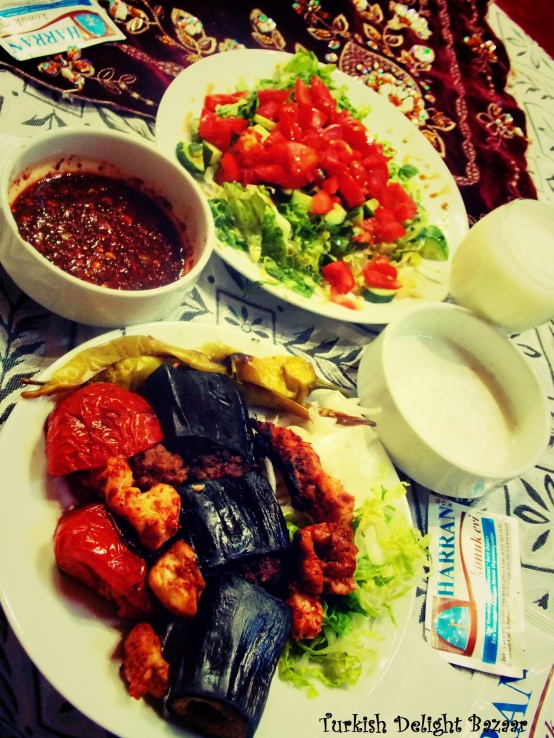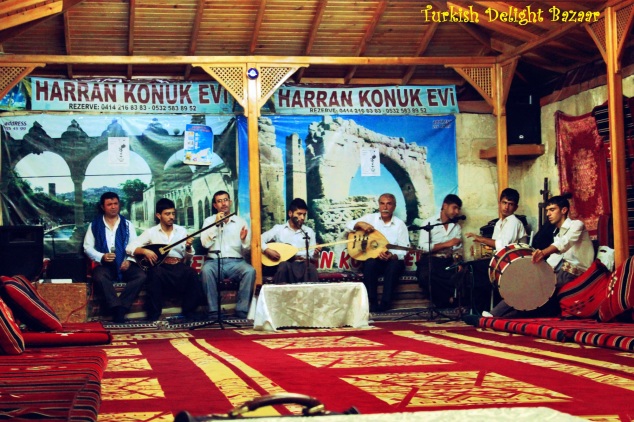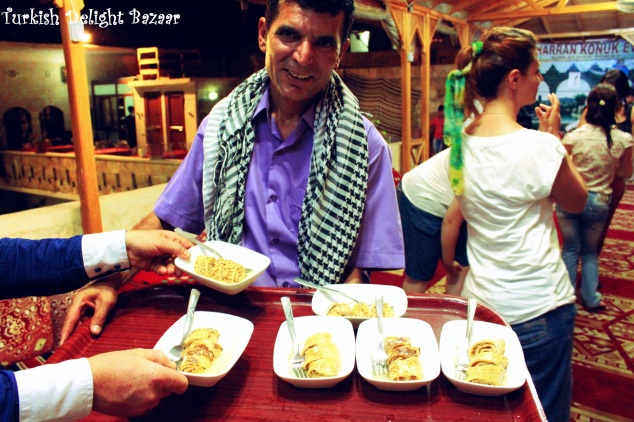Thank you Nicéphore Niépce for inventing photography! When memories start to fade away in our overloaded “hard disk” pictures work like a “Refresh” button!
I sat cross-legged like a Turk and smiled to the camera as I knew that one day this picture will steal a smile and give me back my memories.

And it did. It took me back to the summer of 2012. To my first traditional Turkish evening. In Şanlıurfa. And I decided to take you with me. I won’t hold your hand… but hopefully I’ll hold your imagination. Ready? Imagine yourself entering a 450 year old konuk evi (guest house) in Şanlıurfa. The perfect place for tarihi kokusunu arayanlar (those who are seeking the scent of history) as stated on the Harran guest house’s website. And I was one of them, proud and somehow overwhelmed to be in the place where diverse people, histories and identities meet, in Mesopotamia, the so-called cradle of civilizations… A strange, nameless feeling embraced me and made me realize that we don’t have enough words, and sometimes living our dreams simply paralyzes our thoughts. My introspection was interrupted by the tempting flavors. I must say that South-Eastern Turkey’s history smells delicious. And spoils your tastebuds with its domatesli ve patlıcanlı kebap (tomatoe and eggplant kebab), bostana (Turkish gaspacho), salata (salad), lebeni çorbası (youghurt soup).
 After dinner I found out that preparing çiğ köfte (raw meatballs, yes the meat is actually RAW, is not cooked) requires artistic skills. It is believed that çiğ köfte was invented in Urfa in the time of Abraham. Nimrod (the king of those times) wanted to execute Abraham by setting him on fire and ordered to collect all firewood in Urfa for this purpose. As a result people didn’t have firewood to cook and ate raw food. One day somebody found a way to make meat tastier by adding bulgur, herbs, spices and kneading the mixture. I mentioned above that making çiğ köfte is not an easy task. See the aşçı (cook) in action:
After dinner I found out that preparing çiğ köfte (raw meatballs, yes the meat is actually RAW, is not cooked) requires artistic skills. It is believed that çiğ köfte was invented in Urfa in the time of Abraham. Nimrod (the king of those times) wanted to execute Abraham by setting him on fire and ordered to collect all firewood in Urfa for this purpose. As a result people didn’t have firewood to cook and ate raw food. One day somebody found a way to make meat tastier by adding bulgur, herbs, spices and kneading the mixture. I mentioned above that making çiğ köfte is not an easy task. See the aşçı (cook) in action:
 The best çiğ köfte is made by dancing on the rhythms of the davul (drum) or on the davul 🙂 .
The best çiğ köfte is made by dancing on the rhythms of the davul (drum) or on the davul 🙂 .
 Well, çiğ köfte is not my favourite, and not because is raw meat, at the time I didn’t even know what I was eating! Actually it doesn’t even taste like meat… It’s like a strange combination of herbs and spices worth to try at least once!
Well, çiğ köfte is not my favourite, and not because is raw meat, at the time I didn’t even know what I was eating! Actually it doesn’t even taste like meat… It’s like a strange combination of herbs and spices worth to try at least once!
The hallucinating combination of flavours, the rhythm of the drum and the traditional Turkish music made the evening unforgettable.
 And prepared us for the next level: Halay (Anatolian folk dance) which is quite simple: people form a circle by holding each others little finger and the leading dancer waves a handkerchief.
And prepared us for the next level: Halay (Anatolian folk dance) which is quite simple: people form a circle by holding each others little finger and the leading dancer waves a handkerchief.
 Dancing requires energy, and the best ‘fuel’ to boost your energy are taltılar (sweets), elbette (of course)!
Dancing requires energy, and the best ‘fuel’ to boost your energy are taltılar (sweets), elbette (of course)!



